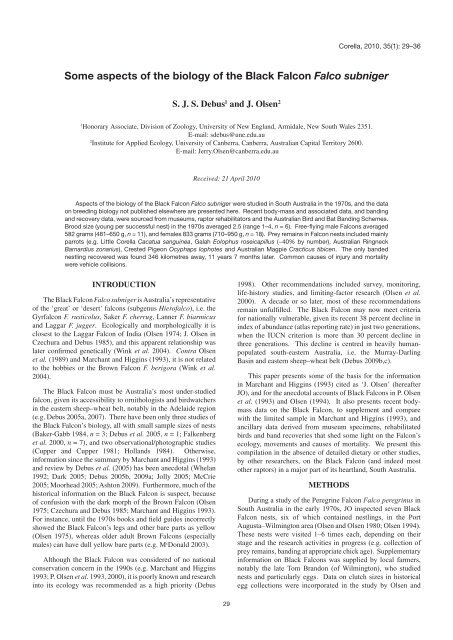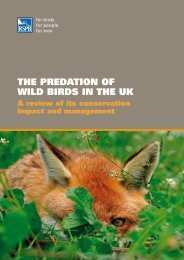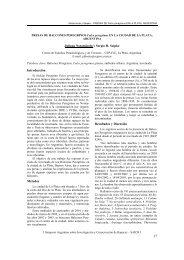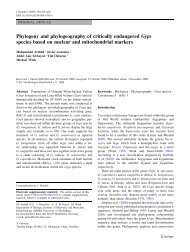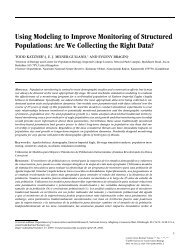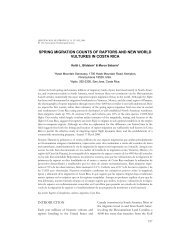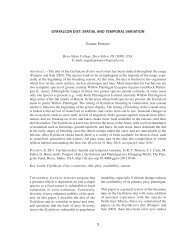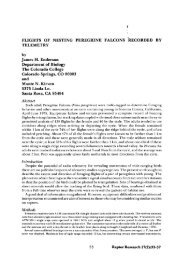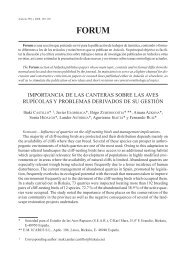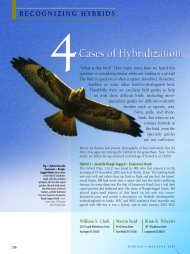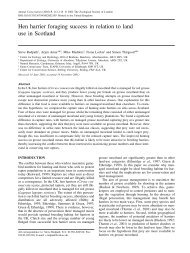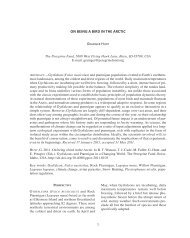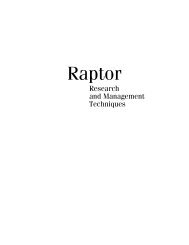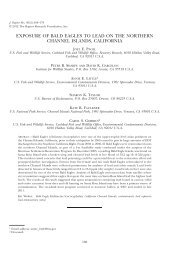Some aspects of the biology of the Black Falcon Falco subniger
Some aspects of the biology of the Black Falcon Falco subniger
Some aspects of the biology of the Black Falcon Falco subniger
You also want an ePaper? Increase the reach of your titles
YUMPU automatically turns print PDFs into web optimized ePapers that Google loves.
Corella, 2010, 35(1): 29–36<strong>Some</strong> <strong>aspects</strong> <strong>of</strong> <strong>the</strong> <strong>biology</strong> <strong>of</strong> <strong>the</strong> <strong>Black</strong> <strong><strong>Falco</strong>n</strong> <strong>Falco</strong> <strong>subniger</strong>S. J. S. Debus 1 and J. Olsen 21Honorary Associate, Division <strong>of</strong> Zoology, University <strong>of</strong> New England, Armidale, New South Wales 2351.E-mail: sdebus@une.edu.au2Institute for Applied Ecology, University <strong>of</strong> Canberra, Canberra, Australian Capital Territory 2600.E-mail: Jerry.Olsen@canberra.edu.auReceived: 21 April 2010Aspects <strong>of</strong> <strong>the</strong> <strong>biology</strong> <strong>of</strong> <strong>the</strong> <strong>Black</strong> <strong><strong>Falco</strong>n</strong> <strong>Falco</strong> <strong>subniger</strong> were studied in South Australia in <strong>the</strong> 1970s, and <strong>the</strong> dataon breeding <strong>biology</strong> not published elsewhere are presented here. Recent body-mass and associated data, and bandingand recovery data, were sourced from museums, raptor rehabilitators and <strong>the</strong> Australian Bird and Bat Banding Schemes.Brood size (young per successful nest) in <strong>the</strong> 1970s averaged 2.5 (range 1–4, n = 6). Free-flying male <strong><strong>Falco</strong>n</strong>s averaged582 grams (481–650 g, n = 11), and females 833 grams (710–950 g, n = 18). Prey remains in <strong><strong>Falco</strong>n</strong> nests included mainlyparrots (e.g. Little Corella Cacatua sanguinea, Galah Eolophus roseicapillus (~40% by number), Australian RingneckBarnardius zonarius), Crested Pigeon Ocyphaps lophotes and Australian Magpie Cracticus tibicen. The only bandednestling recovered was found 346 kilometres away, 11 years 7 months later. Common causes <strong>of</strong> injury and mortalitywere vehicle collisions.INTRODUCTIONThe <strong>Black</strong> <strong><strong>Falco</strong>n</strong> <strong>Falco</strong> <strong>subniger</strong> is Australia’s representative<strong>of</strong> <strong>the</strong> ‘great’ or ‘desert’ falcons (subgenus Hier<strong>of</strong>alco), i.e. <strong>the</strong>Gyrfalcon F. rusticolus, Saker F. cherrug, Lanner F. biarmicusand Laggar F. jugger. Ecologically and morphologically it isclosest to <strong>the</strong> Laggar <strong><strong>Falco</strong>n</strong> <strong>of</strong> India (Olsen 1974; J. Olsen inCzechura and Debus 1985), and this apparent relationship waslater confirmed genetically (Wink et al. 2004). Contra Olsenet al. (1989) and Marchant and Higgins (1993), it is not relatedto <strong>the</strong> hobbies or <strong>the</strong> Brown <strong><strong>Falco</strong>n</strong> F. berigora (Wink et al.2004).The <strong>Black</strong> <strong><strong>Falco</strong>n</strong> must be Australia’s most under-studiedfalcon, given its accessibility to ornithologists and birdwatchersin <strong>the</strong> eastern sheep–wheat belt, notably in <strong>the</strong> Adelaide region(e.g. Debus 2005a, 2007). There have been only three studies <strong>of</strong><strong>the</strong> <strong>Black</strong> <strong><strong>Falco</strong>n</strong>’s <strong>biology</strong>, all with small sample sizes <strong>of</strong> nests(Baker-Gabb 1984, n = 3; Debus et al. 2005, n = 1; Falkenberget al. 2000, n = 7), and two observational/photographic studies(Cupper and Cupper 1981; Hollands 1984). O<strong>the</strong>rwise,information since <strong>the</strong> summary by Marchant and Higgins (1993)and review by Debus et al. (2005) has been anecdotal (Whelan1992; Dark 2005; Debus 2005b, 2009a; Jolly 2005; McCrie2005; Moorhead 2005; Ashton 2009). Fur<strong>the</strong>rmore, much <strong>of</strong> <strong>the</strong>historical information on <strong>the</strong> <strong>Black</strong> <strong><strong>Falco</strong>n</strong> is suspect, because<strong>of</strong> confusion with <strong>the</strong> dark morph <strong>of</strong> <strong>the</strong> Brown <strong><strong>Falco</strong>n</strong> (Olsen1975; Czechura and Debus 1985; Marchant and Higgins 1993).For instance, until <strong>the</strong> 1970s books and field guides incorrectlyshowed <strong>the</strong> <strong>Black</strong> <strong><strong>Falco</strong>n</strong>’s legs and o<strong>the</strong>r bare parts as yellow(Olsen 1975), whereas older adult Brown <strong><strong>Falco</strong>n</strong>s (especiallymales) can have dull yellow bare parts (e.g. M c Donald 2003).Although <strong>the</strong> <strong>Black</strong> <strong><strong>Falco</strong>n</strong> was considered <strong>of</strong> no nationalconservation concern in <strong>the</strong> 1990s (e.g. Marchant and Higgins1993; P. Olsen et al. 1993, 2000), it is poorly known and researchinto its ecology was recommended as a high priority (Debus1998). O<strong>the</strong>r recommendations included survey, monitoring,life-history studies, and limiting-factor research (Olsen et al.2000). A decade or so later, most <strong>of</strong> <strong>the</strong>se recommendationsremain unfulfilled. The <strong>Black</strong> <strong><strong>Falco</strong>n</strong> may now meet criteriafor nationally vulnerable, given its recent 38 percent decline inindex <strong>of</strong> abundance (atlas reporting rate) in just two generations,when <strong>the</strong> IUCN criterion is more than 30 percent decline inthree generations. This decline is centred in heavily humanpopulatedsouth-eastern Australia, i.e. <strong>the</strong> Murray-DarlingBasin and eastern sheep–wheat belt (Debus 2009b,c).This paper presents some <strong>of</strong> <strong>the</strong> basis for <strong>the</strong> informationin Marchant and Higgins (1993) cited as ‘J. Olsen’ (hereafterJO), and for <strong>the</strong> anecdotal accounts <strong>of</strong> <strong>Black</strong> <strong><strong>Falco</strong>n</strong>s in P. Olsenet al. (1993) and Olsen (1994). It also presents recent bodymassdata on <strong>the</strong> <strong>Black</strong> <strong><strong>Falco</strong>n</strong>, to supplement and comparewith <strong>the</strong> limited sample in Marchant and Higgins (1993), andancillary data derived from museum specimens, rehabilitatedbirds and band recoveries that shed some light on <strong>the</strong> <strong><strong>Falco</strong>n</strong>’secology, movements and causes <strong>of</strong> mortality. We present thiscompilation in <strong>the</strong> absence <strong>of</strong> detailed dietary or o<strong>the</strong>r studies,by o<strong>the</strong>r researchers, on <strong>the</strong> <strong>Black</strong> <strong><strong>Falco</strong>n</strong> (and indeed mosto<strong>the</strong>r raptors) in a major part <strong>of</strong> its heartland, South Australia.METHODSDuring a study <strong>of</strong> <strong>the</strong> Peregrine <strong><strong>Falco</strong>n</strong> <strong>Falco</strong> peregrinus inSouth Australia in <strong>the</strong> early 1970s, JO inspected seven <strong>Black</strong><strong><strong>Falco</strong>n</strong> nests, six <strong>of</strong> which contained nestlings, in <strong>the</strong> PortAugusta–Wilmington area (Olsen and Olsen 1980; Olsen 1994).These nests were visited 1–6 times each, depending on <strong>the</strong>irstage and <strong>the</strong> research activities in progress (e.g. collection <strong>of</strong>prey remains, banding at appropriate chick age). Supplementaryinformation on <strong>Black</strong> <strong><strong>Falco</strong>n</strong>s was supplied by local farmers,notably <strong>the</strong> late Tom Brandon (<strong>of</strong> Wilmington), who studiednests and particularly eggs. Data on clutch sizes in historicalegg collections were incorporated in <strong>the</strong> study by Olsen and29
30 S.J.S. Debus and J. Olsen: <strong>Some</strong> <strong>aspects</strong> <strong>of</strong> <strong>the</strong> <strong>biology</strong> <strong>of</strong> <strong>the</strong> <strong>Black</strong> <strong><strong>Falco</strong>n</strong> <strong>Falco</strong> <strong>subniger</strong> Corella 35(1)Marples (1993), and <strong>the</strong> residual, hi<strong>the</strong>rto unpublished dataon <strong>Black</strong> <strong><strong>Falco</strong>n</strong> <strong>biology</strong> are presented here. It is emphasisedthat <strong>the</strong> notes taken on <strong>Black</strong> <strong><strong>Falco</strong>n</strong>s at <strong>the</strong> time were mainlyfor comparison with <strong>the</strong> Peregrine, on which <strong>the</strong> study wasfocussed.Body-mass data for <strong>Black</strong> <strong><strong>Falco</strong>n</strong>s (excluding emaciatedbirds) and related data were sourced from those museumsthat held recent (post-1990) specimens (Australian Museum,Museum Victoria, South Australian Museum; n = 10), and froma raptor rehabilitator in South Australia (Anita Turton, SA Birds<strong>of</strong> Prey Centre; n = 8). The excluded emaciated/dehydratedbirds were those with a body-condition score <strong>of</strong> 1 (i.e. close todeath, where 5 = well-rounded sternum) in Turton’s care, anda museum specimen that had died in care: males <strong>of</strong> 456, 500and 512 grams, and a female <strong>of</strong> 600 grams. Live-weights werealso sourced from <strong>the</strong> Australian Bird and Bat Banding Scheme(n = 6, variously banded by D. Baker-Gabb, G. and A. Cam,P. Driscoll and W. Klau). These weights are here combinedwith live-weights <strong>of</strong> adults trapped or weighed for bandingand/or rehabilitation by JO (n = 10). Recovery data for <strong>Black</strong><strong><strong>Falco</strong>n</strong>s (n = 4) were also sourced from <strong>the</strong> Australian Bird andBat Banding Schemes (ABBBS). The Birds Australia NestRecord Scheme was interrogated for recent (post-1990) data,but despite 11 breeding records for <strong>Black</strong> <strong><strong>Falco</strong>n</strong>s in <strong>the</strong> secondnational bird atlas (Barrett et al. 2003), no fur<strong>the</strong>r nest recordshave been added since <strong>the</strong> analysis by Marchant and Higgins(1993) (G. Ehmke pers. comm.).Breeding <strong>biology</strong>RESULTS AND DICUSSIONAll seven <strong>Black</strong> <strong><strong>Falco</strong>n</strong> nests in South Australia (Port Augustaregion) were located in flat terrain, <strong>of</strong>ten near saltbush (Atriplex)flats or wheat fields, in contrast with Peregrine nests that were oncliffs in <strong>the</strong> nearby Flinders Ranges (see also Olsen 1994). The<strong>Black</strong> <strong><strong>Falco</strong>n</strong> nests were all old raven Corvus sp. nests, usuallyin <strong>the</strong> top <strong>of</strong> riparian River Red Gums Eucalyptus camaldulensison creeklines (see also Olsen 1994), with one near <strong>the</strong> top <strong>of</strong> a30-metre power pylon. (O<strong>the</strong>r areas were searched, and o<strong>the</strong>rraptors did nest in low trees and bushes, but <strong>the</strong>se <strong>Black</strong> <strong><strong>Falco</strong>n</strong>sused <strong>the</strong> only tall trees available, which were on creeklines.)<strong>Black</strong> <strong><strong>Falco</strong>n</strong>s used old raven nests for several years running,without refurbishment by <strong>the</strong> ravens each year, but when nestsstarted to deteriorate <strong>the</strong>y chose ano<strong>the</strong>r (JO).All <strong>Black</strong> <strong><strong>Falco</strong>n</strong> nests were exposed, open to sun, windand rain, suggesting that <strong>the</strong> <strong>Black</strong> <strong><strong>Falco</strong>n</strong>, in contrast with <strong>the</strong>cliff-nesting Peregrine, is tolerant <strong>of</strong> sunlight and heat. <strong>Black</strong><strong><strong>Falco</strong>n</strong>s are said to sometimes nest on low bushes in <strong>the</strong> inland(Marchant and Higgins 1993; Ferguson-Lees and Christie 2001),which we regard as highly unlikely and probably referableto Brown <strong><strong>Falco</strong>n</strong>s using low corvid or eagle nests. In ourexperience <strong>Black</strong> <strong><strong>Falco</strong>n</strong>s select <strong>the</strong> highest nests in <strong>the</strong> tallesttrees available (Debus et al. 2005; JO pers. obs.; SD pers. obs.)and to date <strong>the</strong>re is no reliable evidence to <strong>the</strong> contrary, given<strong>the</strong> confounding effect <strong>of</strong> misidentified Brown <strong><strong>Falco</strong>n</strong>s.Average brood size <strong>of</strong> <strong>the</strong> <strong>Black</strong> <strong><strong>Falco</strong>n</strong> in sou<strong>the</strong>rn SouthAustralia was given as about three (from Brandon’s historicaldata from <strong>the</strong> Wilmington district), compared with <strong>the</strong>Peregrine’s average <strong>of</strong> two (Olsen 1994). However, brood sizein <strong>the</strong> six <strong>Black</strong> <strong><strong>Falco</strong>n</strong> nests inspected by JO in <strong>the</strong> same regionaveraged 2.5 nestlings (range 1–4): B/1 × 2, B/3 × 3, B/4 × 1.Sakers, Laggars and o<strong>the</strong>r ‘great’ falcons use cliff nests<strong>of</strong>ten, as well as stick nests (Ferguson-Lees and Christie 2001).However, <strong>the</strong> <strong>Black</strong> <strong><strong>Falco</strong>n</strong> does not use cliffs, thus limiting itsbreeding opportunities compared with Australian Peregrines.The latter, unlike elsewhere in <strong>the</strong> world, have cliffs largely to<strong>the</strong>mselves, free <strong>of</strong> o<strong>the</strong>r eagle and competing falcon species(fur<strong>the</strong>r discussion by Olsen et al. 2006). Disregarding <strong>the</strong>smaller Nankeen Kestrel <strong>Falco</strong> cenchroides, exceptions aresome localised Eastern Osprey Pandion cristatus and WhitebelliedSea-Eagle Haliaeetus leucogaster nests on coastalcliffs (mainly in SA: Marchant and Higgins 1993). The o<strong>the</strong>rmedium–large Australian falcons (Grey F. hypoleucos andBrown) are also restricted to using stick nests, typically high,fresh corvid nests (Marchant and Higgins 1993; M c Donald et al.2003), thus raising <strong>the</strong> possibility <strong>of</strong> interspecific competitionbetween <strong>Black</strong>, Grey and <strong>the</strong> abundant Brown <strong><strong>Falco</strong>n</strong> for nestsites (especially where many trees have been removed from <strong>the</strong>landscape or are dying, i.e. <strong>the</strong> sheep–wheat belt). Nest sitesmay be a limiting resource for <strong>Black</strong> <strong><strong>Falco</strong>n</strong>s in some areas.VocalisationsThe <strong>Black</strong> <strong><strong>Falco</strong>n</strong>’s commonest call at <strong>the</strong> nest is said to bea harsh scream (Ferguson-Lees and Christie 2001), based onHollands (1984) who added ‘lower pitched than Peregrine withmore <strong>the</strong> crowing character <strong>of</strong> <strong>the</strong> Brown <strong><strong>Falco</strong>n</strong>’. Hollandsappears to have used ‘scream’ as a catch-all term for <strong>the</strong>various cackling and whining calls <strong>of</strong> <strong>the</strong> <strong>Black</strong> and Peregrine<strong><strong>Falco</strong>n</strong>s. The <strong>Black</strong> <strong><strong>Falco</strong>n</strong> does utter a harsh gaaaar or kaaaar(Marchant and Higgins 1993), somewhat like <strong>the</strong> call <strong>of</strong> a WhitefacedHeron Egretta novaehollendiae (JO). However, in ourexperience <strong>the</strong> commonest calls around <strong>the</strong> nest are a gutturalcackle and <strong>the</strong> female’s begging whine or wail (Debus et al.2005). The <strong>Black</strong> <strong><strong>Falco</strong>n</strong>’s cackling call is a deep chug-chug…,more like that <strong>of</strong> <strong>the</strong> Saker and Gyrfalcon (i.e. o<strong>the</strong>r ‘great’falcons) than <strong>the</strong> Peregrine (JO). This similarity is reinforcedby sonagrams <strong>of</strong> <strong>the</strong> respective calls <strong>of</strong> <strong>the</strong> Gyrfalcon and <strong>Black</strong><strong><strong>Falco</strong>n</strong> (cf. Clum and Cade 1994; Jurisevic 1998).Marchant and Higgins (1993) repeated <strong>the</strong> claim that <strong>Black</strong><strong><strong>Falco</strong>n</strong>s sometimes scream or cackle when attacking prey, butin our experience <strong>Black</strong> <strong><strong>Falco</strong>n</strong>s are silent when attacking,and most (if not all) such claims are probably based on Brown<strong><strong>Falco</strong>n</strong>s (Czechura and Debus 1985).PreyOlsen et al. (1979) noted that, in <strong>the</strong> flat parts <strong>of</strong> <strong>the</strong>ir studyarea in South Australia, <strong>Black</strong> <strong><strong>Falco</strong>n</strong>s compete directly withPeregrines for prey (meaning <strong>the</strong>y take <strong>the</strong> same prey species).P. Olsen et al. (1993) and Olsen (1974, 1994) described andcompared anecdotally <strong>the</strong> hunting methods, flight performanceand some prey items <strong>of</strong> both species in that area, including<strong>the</strong> methods used by <strong>Black</strong> <strong><strong>Falco</strong>n</strong>s to catch Galahs Eolophusroseicapillus and various pigeon species. <strong>Black</strong> <strong><strong>Falco</strong>n</strong>s differfrom Peregrines in plumage features (e.g. more flexible flightfea<strong>the</strong>rs),manoeuvrability and hunting methods (e.g. greateruse <strong>of</strong> tactics such as mediated flushing and kleptoparasitism;
March 2011 S.J.S. Debus and J. Olsen: <strong>Some</strong> <strong>aspects</strong> <strong>of</strong> <strong>the</strong> <strong>biology</strong> <strong>of</strong> <strong>the</strong> <strong>Black</strong> <strong><strong>Falco</strong>n</strong> <strong>Falco</strong> <strong>subniger</strong> 31fur<strong>the</strong>r discussion by Czechura and Debus 1985 and Olsen 1974,1994). Additional to <strong>the</strong> descriptions <strong>of</strong> <strong>Black</strong> <strong><strong>Falco</strong>n</strong> huntingmethods published elsewhere (Marchant and Higgins 1993;Olsen 1994), Olsen (1974) also noted that <strong>the</strong> <strong><strong>Falco</strong>n</strong> catchesGalahs by flying over <strong>the</strong> treetops and taking <strong>the</strong>m by surprise (afrequent, but unquantified, observation). SD has also observedsuch treetop-hugging foraging flights, sometimes by a pair <strong>of</strong><strong>Black</strong> <strong><strong>Falco</strong>n</strong>s (once at a foraging Musk Lorikeet Glossopsittaconcinna in <strong>the</strong> canopy). In South Australia, <strong>Black</strong> <strong><strong>Falco</strong>n</strong>shave been observed taking Stubble Quail Coturnix pectoralis,Little Button-quail Turnix velox, Horsfield’s Bushlarks Mirafrajavanica, Australasian Pipits Anthus novaeseelandiae and aZebra Finch Taeniopygia guttata flushed by farm machinery,vehicles or mobs <strong>of</strong> sheep; <strong>the</strong> finch, and House Mice Musmusculus and Plague Locusts Chortoicetes terminifera, wereeaten in flight (L. Pedler pers. comm.).Prey remains in <strong>Black</strong> <strong><strong>Falco</strong>n</strong> nests in South Australiaincluded Crested Pigeon Ocyphaps lophotes, Little CorellaCacatua sanguinea, Galah, Australian Ringneck Barnardiuszonarius, Blue Bonnet Northiella haematogaster, BudgerigarMelopsittacus undulatus, honeyeaters (Meliphagidae),Australian Magpie Cracticus tibicen, Fairy Martin Petrochelidonariel and Common Starling Sturnus vulgaris, with Galahscontributing about 40 percent <strong>of</strong> vertebrate prey by number. J.Jolly (pers. comm.) reported Starlings taking refuge amongstand under mobs <strong>of</strong> sheep to escape hunting <strong>Black</strong> <strong><strong>Falco</strong>n</strong>s,and <strong>the</strong> <strong><strong>Falco</strong>n</strong>s trying to flush <strong>the</strong>m out. The proportion <strong>of</strong>Galah, by number, is greater than that recorded by Baker-Gabb(1984) and Debus et al. (2005) (18% and 19% <strong>of</strong> vertebrateprey, respectively), but Galahs were superabundant in JO’sstudy area.In contrast, immature Rabbit Oryctolagus cuniculus was<strong>the</strong> <strong>Black</strong> <strong><strong>Falco</strong>n</strong>’s dominant prey in arid South Australia andVictoria in <strong>the</strong> 1970s, i.e. pre-calicivirus (Cupper and Cupper1981; Hollands 1984; Baker-Gabb 1984). The <strong>Black</strong> <strong><strong>Falco</strong>n</strong>also preys on plaguing Long-haired Rats Rattus villosissimusin <strong>the</strong> arid zone (Hollands 1984). Limited recent data from aridSouth Australia concern <strong>the</strong> remains <strong>of</strong> three rabbits and oneGalah at two <strong>Black</strong> <strong><strong>Falco</strong>n</strong> nests in 1995, as <strong>the</strong> calicivirus wasarriving in <strong>the</strong> region (Falkenberg et al. 2000). Perhaps <strong>Black</strong><strong><strong>Falco</strong>n</strong>s behave like Sakers or Lanners, taking many small groundmammals when <strong>the</strong>y are superabundant (cf. Ferguson-Lees andChristie 2001). However, JO did not record rabbit as prey in<strong>the</strong> South Australian nests, despite rabbits being abundant in <strong>the</strong>area and <strong>the</strong> common prey at Wedge-tailed Eagle Aquila audaxnests. We regard <strong>the</strong> <strong>Black</strong> <strong><strong>Falco</strong>n</strong> as primarily a bird-catcher(Olsen 1994; Debus et al. 2005; JO pers. obs.).Similarly, <strong>the</strong> many recent studies <strong>of</strong> eagle and falcon dietsin south-eastern Australia (e.g. our studies published elsewhere,partly reviewed by Olsen et al. 2010; Debus et al. 2005) <strong>of</strong>tenshow fewer rabbits taken than in past decades in <strong>the</strong> sameregions. This contrast may reflect trends in rabbit numbersand o<strong>the</strong>r prey, or possibly differences in dietary analyses aswell (e.g. see Olsen et al. 2010). For instance, <strong>the</strong>re may be asampling bias: rabbit remains may last in or under falcon nestslonger (because leg bones are not eaten), whereas small birdsmay be eaten entirely and <strong>the</strong>ir remains dropped away from <strong>the</strong>nest as a pellet (P. M c Donald pers. comm.). Wind and ants mayalso disperse or remove fea<strong>the</strong>rs and small, fragile remains (G.Czechura pers. comm.), but, on <strong>the</strong> o<strong>the</strong>r hand, scavengers mayremove bones and o<strong>the</strong>r large remains.<strong>Black</strong> <strong><strong>Falco</strong>n</strong> prey records in this study are a subset <strong>of</strong>Peregrine prey from <strong>the</strong> same area (cf. J. Olsen et al. 1993).In <strong>the</strong> arid zone, <strong>the</strong>re is much dietary overlap between <strong>the</strong><strong>Black</strong> <strong><strong>Falco</strong>n</strong> and Grey <strong><strong>Falco</strong>n</strong> (cf. Marchant and Higgins 1993;Falkenberg 2011; Sutton 2011). The Brown <strong><strong>Falco</strong>n</strong>, whoserange encompasses that <strong>of</strong> <strong>the</strong> <strong>Black</strong> <strong><strong>Falco</strong>n</strong>, also overlaps with<strong>the</strong> latter in vertebrate food (birds, small mammals and somecarrion, cf. Marchant and Higgins 1993; M c Donald et al. 2003;Debus et al. 2005; M c Donald and Baker-Gabb 2006).PlumageThe <strong>Black</strong> <strong><strong>Falco</strong>n</strong>’s plumages are poorly understood, andreadily confused with those <strong>of</strong> dark Brown <strong><strong>Falco</strong>n</strong>s. Breedingadult <strong>Black</strong> <strong><strong>Falco</strong>n</strong>s tend to be lighter-coloured (browner) thanjuveniles, with an evident malar stripe, whereas in <strong>the</strong> darkerjuveniles <strong>the</strong> malar stripe blends with <strong>the</strong> overall colouration(Figure 1a, Figure 2). Most fea<strong>the</strong>red nestling <strong>Black</strong> <strong><strong>Falco</strong>n</strong>sexamined by JO were typically dark (e.g. Marchant and Higgins1993). However, one was light in colour, with a clear malarstripe, pale edging on its back fea<strong>the</strong>rs and some barring underits wings and tail, resembling what might be called an adult(Figure 1b). O<strong>the</strong>r juvenile characters are discussed by Debuset al. (2005).A rare sooty-grey (i.e. dark grey) colour form <strong>of</strong> <strong>the</strong><strong>Black</strong> <strong><strong>Falco</strong>n</strong> is alleged to exist (e.g. P. Olsen et al. 1993); itsupperparts are said to be slate-grey as in <strong>the</strong> Australian Hobby<strong>Falco</strong> longipennis (Marchant and Higgins 1993; Ferguson-Leesand Christie 2001). This was not so in three examples recordedby JO (a pair and a juvenile; Figure 3a,b). These birds, andano<strong>the</strong>r pair observed by J. Jolly (pers. comm., also in SA), hada smoky-grey wash on <strong>the</strong> mantle, a grey cast to <strong>the</strong> remiges andrectrices and a hint <strong>of</strong> dorsal barring on <strong>the</strong> tail, but were littledifferent from normal <strong>Black</strong> <strong><strong>Falco</strong>n</strong>s (see Figure 4). Similarly,o<strong>the</strong>r observers with extensive experience <strong>of</strong> <strong>Black</strong> <strong><strong>Falco</strong>n</strong>s inSouth Australia have not observed a ‘grey’ form distinguishablefrom a wea<strong>the</strong>red adult (T. Dennis and L. Pedler pers. comm.).Serventy and Whittell (1976) noted that <strong>the</strong> <strong>Black</strong> <strong><strong>Falco</strong>n</strong> hasa ‘greyish-blue bloom’ to <strong>the</strong> plumage, which may reach <strong>the</strong>extreme <strong>of</strong> individual variation in <strong>the</strong> bird illustrated herein(Figures 3, 4). Thus, we suspect that a ‘grey’ morph does notexist, and that such plumages are attributable to a grey wash orbloom, fea<strong>the</strong>r wear and perhaps lighting effects. A ‘grey’ formis not admitted by <strong>the</strong> standard Australian bird field-guides,although Slater et al. (2009) aptly described <strong>the</strong> [normal] <strong>Black</strong><strong><strong>Falco</strong>n</strong> as ‘dark slaty-brown’.As many juvenile Brown <strong><strong>Falco</strong>n</strong>s are very dark, with somebuff mainly on <strong>the</strong> collar, throat and belly/crissum (Marchantand Higgins 1993), <strong>the</strong>re is much risk <strong>of</strong> confusion with <strong>Black</strong><strong><strong>Falco</strong>n</strong> nestlings; some early banding records <strong>of</strong> ‘<strong>Black</strong> <strong><strong>Falco</strong>n</strong>’nestlings may have been Brown <strong><strong>Falco</strong>n</strong>s (JO). False data mayinflate <strong>Black</strong> <strong><strong>Falco</strong>n</strong> population and productivity figures andthus create an overly optimistic impression, and perhaps havecontaminated <strong>the</strong> Nest Record Scheme analysis in Marchant andHiggins (1993), and indeed probably atlas and o<strong>the</strong>r databases.However, <strong>the</strong> only two weighed <strong>Black</strong> <strong><strong>Falco</strong>n</strong> nestlings in <strong>the</strong>ABBBS were correctly identified (see below).
32 S.J.S. Debus and J. Olsen: <strong>Some</strong> <strong>aspects</strong> <strong>of</strong> <strong>the</strong> <strong>biology</strong> <strong>of</strong> <strong>the</strong> <strong>Black</strong> <strong><strong>Falco</strong>n</strong> <strong>Falco</strong> <strong>subniger</strong> Corella 35(1)aFigure 2. The same ‘normal’ (dark) juvenile <strong>Black</strong> <strong><strong>Falco</strong>n</strong> as inFig. 1a, at 8–10 weeks old.Photos: Jerry Olsen.Body weightsFor free-flying <strong>Black</strong> <strong><strong>Falco</strong>n</strong>s aged 1+ or older, sexed bydissection (<strong>the</strong> recent museum specimens) or by experiencedraptor biologists and rehabilitators (n = 29 in total), malesaveraged 582 grams (range 481–650 g, s.d. = 59.8, n = 11) andfemales averaged 833 grams (range 710–960 g, s.d. = 90.3, n =18). In addition, two advanced female nestlings at banding ageweighed 810 and 840 grams, and two unsexed free-flying birdsaged 1 and 1+ weighed 640 and 647 grams (ABBBS data), i.e.probably males on <strong>the</strong> above basis. Inclusion <strong>of</strong> <strong>the</strong>se last twowould amend <strong>the</strong> male mean to 592 grams (s.d. = 59.2, n = 13),which may be more realistic for healthy wild birds. (We notehere that <strong>of</strong> 154 <strong>Black</strong> <strong><strong>Falco</strong>n</strong>s in <strong>the</strong> ABBBS, half <strong>of</strong> whichwere free-flying, i.e. age 1+, only six had been weighed.)The <strong>Black</strong> <strong><strong>Falco</strong>n</strong> is strongly sexually size-dimorphicin body mass, and <strong>the</strong> data herein raise <strong>the</strong> possibility that afew <strong>of</strong> <strong>the</strong> old museum specimens (used for body weights inMarchant and Higgins 1993) may have been mis-sexed. Forexample, <strong>the</strong> 610-gram ‘female’ museum specimen in Marchantand Higgins (1993) and Ferguson-Lees and Christie (2001) islikely to have been mis-sexed, sick or desiccated. As a fur<strong>the</strong>rcaution against underweight (sick) birds, a rescued nestling thatwas assumed male on <strong>the</strong> basis <strong>of</strong> live-weight (495 g), and died<strong>of</strong> trichomoniasis, was found to be female on dissection (AMO.71022: Debus et al. 2005; data per W. Boles).Specimens, band recoveries and o<strong>the</strong>r databFigure 1. (a) ‘Normal’ (dark) juvenile <strong>Black</strong> <strong><strong>Falco</strong>n</strong>, ~10months old, and (b) light juvenile <strong>Black</strong> <strong><strong>Falco</strong>n</strong>, seven weeksold, showing atypical (for juveniles) light face and clear malarstripe; both from South Australia. Photos: Jerry Olsen.For <strong>the</strong> museum specimens, five birds from South Australia(all females) were noted as road kill (two), hit by car (two), andfound injured (one); one <strong>of</strong> <strong>the</strong> car casualties was feeding on aFox Vulpes vulpes cub carcass on <strong>the</strong> road (P. Willcock pers.comm.). Two female <strong><strong>Falco</strong>n</strong>s had bird remains and probablerabbit remains in <strong>the</strong>ir stomachs, respectively, and a third (roadkill) had chunks <strong>of</strong> meat but no o<strong>the</strong>r remains in its stomach,i.e. probable scavenging on a large road-kill carcass (data perP. Horton). For <strong>the</strong> Australian Museum specimens, at least two
March 2011 S.J.S. Debus and J. Olsen: <strong>Some</strong> <strong>aspects</strong> <strong>of</strong> <strong>the</strong> <strong>biology</strong> <strong>of</strong> <strong>the</strong> <strong>Black</strong> <strong><strong>Falco</strong>n</strong> <strong>Falco</strong> <strong>subniger</strong> 33Figure 4. The same adult <strong>Black</strong> <strong><strong>Falco</strong>n</strong> as in Fig. 3 (fi lmcorrectly exposed).Photo: Jerry Olsen.<strong>of</strong> four (a male and a female) originated from main roadways,i.e. probable road kills (data per W. Boles; stomach contentsgiven by Debus et al. 2005). At least two <strong>of</strong> <strong>the</strong> road-killedfemales were adults, with convoluted oviducts (i.e. had bred),which suggests that not only juveniles scavenge road kill (cf.Debus et al. 2005). These incidents support <strong>the</strong> view that <strong>the</strong><strong>Black</strong> <strong><strong>Falco</strong>n</strong> feeds on carrion more frequently than do mosto<strong>the</strong>r Australian falcons, though less so than <strong>the</strong> Brown <strong><strong>Falco</strong>n</strong>(cf. Marchant and Higgins 1993; Ferguson-Lees and Christie2001). For instance, SD has observed a pair <strong>of</strong> <strong>Black</strong> <strong><strong>Falco</strong>n</strong>sfeeding on a road-killed macropod in central Queensland.One specimen (Australian Museum) consisted <strong>of</strong> <strong>Black</strong><strong><strong>Falco</strong>n</strong> bones found in a Wedge-tailed Eagle nest near BrokenHill (western NSW), and male <strong>Black</strong> <strong><strong>Falco</strong>n</strong> remains werefound in a Peregrine cliff nest at 1000 metres elevation nearCanberra (J. Olsen, A. B. Rose and W. Boles unpubl. data). ThatPeregrine pair commonly took Australian and Little RavensCorvus coronoides and C. mellori (Olsen et al. 2004).Figure 3. (a) Dorsal and (b) ventral view <strong>of</strong> adult <strong>Black</strong> <strong><strong>Falco</strong>n</strong>from South Australia: grey-washed plumage variant (fi lmslightly over-exposed).Photos: Jeff Jolly.Among 12 <strong>Black</strong> <strong><strong>Falco</strong>n</strong>s received by <strong>the</strong> South AustralianBirds <strong>of</strong> Prey Centre, 2002–2009, were: six hit by cars (onejuvenile and two adult females, one juvenile and one adultmale); two gunshot victims (one 1+ female, one juvenile male);two unspecified collision victims (adult female, adult male); onenestling taken illegally from a nest (but confiscated and takeninto care); and one nestling that was in unspecified difficulty(rescued and taken into care).Details <strong>of</strong> <strong>the</strong> four banded <strong>Black</strong> <strong><strong>Falco</strong>n</strong>s recovered (a 3%recovery rate, <strong>of</strong> 154 banded) are as follows. The Mallala birdswere trapped in a pigeon-fancier’s pigeon barn (using padded legholdrabbit traps that sometimes accidentally injured <strong>the</strong> <strong><strong>Falco</strong>n</strong>sand caused ethical issues with <strong>the</strong> authorities; see Olsen 1994).
34 S.J.S. Debus and J. Olsen: <strong>Some</strong> <strong>aspects</strong> <strong>of</strong> <strong>the</strong> <strong>biology</strong> <strong>of</strong> <strong>the</strong> <strong>Black</strong> <strong><strong>Falco</strong>n</strong> <strong>Falco</strong> <strong>subniger</strong> Corella 35(1)Mallala (SA), 9 March 1990, age 1+, sex unknown:recaptured in cage trap at banding place on 5 April 1996 after72 months, released alive with band.Mallala (SA), 2 February 1994, age 1+, sex unknown:recaptured by hand/hand-held net at banding place on 5 April1997 after 38 months, released alive with band.Mallala (SA), 8 December 1994, age 1+, sex unknown:found sick or injured at Two Wells (SA) on 5 April 1995 threemonths later, 14 km south-east (rehabilitated in captivity).Pirlta (Victoria), 20 September 1980, nestling, sex unknown:found fatally injured (mercy killed) on highway near PortWakefield (SA) on 4 May 1992 139 months later, 346 kilometreswest.The Mallala birds were all trapped in summer/autumn andall five birds were recovered in that region in autumn: a seasonwhen <strong>the</strong> <strong>Black</strong> <strong><strong>Falco</strong>n</strong> was locally noted as a visitor to <strong>the</strong> wheatfields <strong>of</strong> <strong>the</strong> district, with up to 13–14 ga<strong>the</strong>ring at local gluts <strong>of</strong>prey such as locusts (M. Waterman pers. comm.). Similarly,on <strong>the</strong> South Australian coast at Encounter Bay, <strong>Black</strong> <strong><strong>Falco</strong>n</strong>sare seen annually in late summer/autumn, apparently attractedto <strong>the</strong> large numbers <strong>of</strong> feral Rock Doves Columba livia andCommon Starlings roosting on near-shore islands (T. Dennispers. comm.). Conversely, <strong>Black</strong> <strong><strong>Falco</strong>n</strong>s leave <strong>the</strong> Adelaideregion in winter (P. Willcock pers. comm.).The Pirlta to Port Wakefield recovery represents a longevity(11 years 7 months) and distance record for a wild <strong>Black</strong> <strong><strong>Falco</strong>n</strong>.These few birds (not aged or sexed) illustrate a wide variationin occurrence and movements, from being present at a givenlocality after 3–6 years (no implication about <strong>the</strong>ir movementsor locations in <strong>the</strong> interim), to moving 14 kilometres from thatlocality in three months, to juvenile dispersal <strong>of</strong> ~350 kilometresto that same locality (a post-breeding destination?). A pair <strong>of</strong><strong>Black</strong> <strong><strong>Falco</strong>n</strong>s appeared to maintain a temporary summer (postbreeding)territory at Werribee (coastal Victoria), where <strong>the</strong> twobirds regularly roosted toge<strong>the</strong>r but did not breed (P. M c Donaldpers. comm.).<strong>Black</strong> <strong><strong>Falco</strong>n</strong>s used to be seen fairly <strong>of</strong>ten around Canberra(Olsen 1975), but are rarely if ever seen <strong>the</strong>re nowadays (JOper. obs.). This trend is supported by <strong>the</strong> annual bird reports <strong>of</strong><strong>the</strong> Canberra Ornithologists Group, published in Canberra BirdNotes. In <strong>the</strong>se, <strong>the</strong> <strong><strong>Falco</strong>n</strong> went from a reportedly uncommonbreeding summer migrant, with records in most years (~5 peryear) in <strong>the</strong> 1980s, to a rare visitor in <strong>the</strong> 1990s (~2 recordsper year in <strong>the</strong> few years with records) and 2000s (occasionalin autumn, notably in <strong>the</strong> drought years <strong>of</strong> <strong>the</strong> mid-2000s).However, more systematic study is needed, as <strong>the</strong> <strong>Black</strong><strong><strong>Falco</strong>n</strong> has never been confirmed to breed near Canberra (JO).This trend in sightings may reflect <strong>the</strong> <strong>Black</strong> <strong><strong>Falco</strong>n</strong>’s recentpopulation trend, and perhaps breeding success, in <strong>the</strong> Murray-Darling Basin (cf. Debus 2009b,c). Similarly, at high elevation(>1000 m asl) on <strong>the</strong> Nor<strong>the</strong>rn Tablelands <strong>of</strong> New South Wales,<strong>the</strong> few <strong>Black</strong> <strong><strong>Falco</strong>n</strong> sightings (1–2 per year) over <strong>the</strong> past 20years fall in summer–autumn (SD), with <strong>the</strong> nearest knownbreeding population at much lower elevation (~400 m asl) in avalley <strong>of</strong> <strong>the</strong> North-west Slopes (Debus et al. 2005).How much <strong>of</strong> <strong>the</strong> foregoing regional decline represents anAustralia-wide shift in <strong>the</strong> <strong>Black</strong> <strong><strong>Falco</strong>n</strong> population (e.g. morefrequent and prolonged occurrences in <strong>the</strong> drier coastal valleys<strong>of</strong> south-east Qld: G. Czechura pers. comm.), or perhaps aresponse to changing fire regimes, is unclear pending fur<strong>the</strong>rdata.CONCLUSIONSThere are few o<strong>the</strong>r data with which to compare <strong>the</strong> <strong>Black</strong><strong><strong>Falco</strong>n</strong>’s breeding productivity in South Australia. Baker-Gabb(1984) recorded 12 young raised in six pair-years (mean = twoyoung per attempt) in a climatically similar area in Victoria.Falkenberg et al. (2000) recorded a mean <strong>of</strong> two young per pairover eight pair-years pre-calicivirus, and one per pair (n = twopairs) in <strong>the</strong> first year post-calicivirus, with breeding failure(i.e. no pairs at that study site) in <strong>the</strong> next two years, in <strong>the</strong>South Australian arid zone (a non-significant difference, given<strong>the</strong> sample sizes). However, with such a small sample size andshort interval in <strong>the</strong> 1990s, a climatic effect ra<strong>the</strong>r than an effect<strong>of</strong> rabbit decline cannot be ruled out, and researchers may nothave found or searched for alternative nests. For instance, <strong>Black</strong><strong><strong>Falco</strong>n</strong>s, which do not refurbish nests, moved several kilometresto alternative (newer) raven nests, used by ravens in <strong>the</strong> previousyear, in South Australia (JO).Post-calicivirus, populations <strong>of</strong> rabbit-eating raptors showedno significant change in relation to rabbit abundance (Steele andBaker-Gabb 2009). Clearly, <strong>the</strong>re is a need for contemporarydata on nest occupancy and breeding productivity from samplelocations around <strong>the</strong> country, over several years, to complementatlas survey data, in order to elucidate <strong>the</strong> <strong>Black</strong> <strong><strong>Falco</strong>n</strong>’sconservation status and population trends (e.g. Olsen et al.2009). The need for studies <strong>of</strong> breeding pairs is crucial becauseatlas surveys <strong>of</strong> raptors, as opposed to smaller bird species, canmisrepresent breeding numbers (Sergio et al. 2008; Olsen et al.2009). For instance, <strong>Black</strong> <strong><strong>Falco</strong>n</strong>s are still frequently seen atfood sources in parts <strong>of</strong> sou<strong>the</strong>rn South Australia (e.g. up toeight around an abattoir near Adelaide), although nests are notfound (J. Jolly and P. Willcock pers. comm.), whereas Olsen(1994) noted <strong>the</strong> loss <strong>of</strong> some <strong>Black</strong> <strong><strong>Falco</strong>n</strong> and o<strong>the</strong>r raptorbreeding pairs following <strong>the</strong> destruction <strong>of</strong> riparian woodlandin his South Australian study area. These are non-systematicobservations, and may not reflect <strong>the</strong> true status <strong>of</strong> <strong>the</strong> <strong>Black</strong><strong><strong>Falco</strong>n</strong> in South Australia. Fur<strong>the</strong>rmore, Olsen et al. (2009)showed that even systematic surveys <strong>of</strong> raptor sightings canmask a species’ decline: breeding Little Eagles Hieraaetusmorphnoides in <strong>the</strong> Australian Capital Territory had declineddramatically, but data from annual bird surveys suggested thatnumbers were stable.Limited data on <strong>the</strong> <strong>Black</strong> <strong><strong>Falco</strong>n</strong>’s breeding diet in SouthAustralia confirm that it is largely a bird hunter, and that itsavian diet overlaps almost completely with that <strong>of</strong> <strong>the</strong> Peregrine,although <strong>Black</strong> <strong><strong>Falco</strong>n</strong>s take more mammals and carrion.<strong>Black</strong> <strong><strong>Falco</strong>n</strong> prey records in this study are a subset <strong>of</strong> <strong>the</strong><strong>Black</strong> <strong><strong>Falco</strong>n</strong>’s breeding diet elsewhere (cf. Baker-Gabb 1984;Marchant and Higgins 1993; Debus et al. 2005). Althoughgenerally not rabbit-dependent, <strong>the</strong> <strong>Black</strong> <strong><strong>Falco</strong>n</strong> may be afacultative opportunist on abundant mammals, and on abundantflying insects (e.g. locusts); it may also take larger prey when
March 2011 S.J.S. Debus and J. Olsen: <strong>Some</strong> <strong>aspects</strong> <strong>of</strong> <strong>the</strong> <strong>biology</strong> <strong>of</strong> <strong>the</strong> <strong>Black</strong> <strong><strong>Falco</strong>n</strong> <strong>Falco</strong> <strong>subniger</strong> 35feeding young (e.g. Olsen and Tucker 2003; Debus et al. 2005).In <strong>the</strong> study by Falkenberg et al. (2000), <strong>Black</strong> <strong><strong>Falco</strong>n</strong>s may haveresponded to a post-calicivirus shortage <strong>of</strong> rabbits by switchingprey or by not breeding (cf. Olsen et al. 2010), and thus were notattached to nests until conditions (e.g. ground cover, avian prey)improved.The <strong>Black</strong> <strong><strong>Falco</strong>n</strong>’s plumage is variable, such that bandersand observers should exercise caution in assigning age classes tobirds in <strong>the</strong> field on <strong>the</strong> basis <strong>of</strong> plumage alone, and include o<strong>the</strong>rcues such as plumage wear and moult, <strong>the</strong> plumage condition andbehaviour <strong>of</strong> associating individuals (e.g. adults with dependentjuveniles), and bare-part colouration (see Debus et al. 2005).The body-mass data confirm <strong>the</strong> strong sexual size dimorphismin this species, and its similarity in body size to <strong>the</strong> Peregrine<strong><strong>Falco</strong>n</strong> (male 600 g, female 825 g, cf. Marchant and Higgins 1993).Banding, recovery and rehabilitation data highlight <strong>the</strong> need forfur<strong>the</strong>r investigation <strong>of</strong> <strong>the</strong> <strong>Black</strong> <strong><strong>Falco</strong>n</strong>’s movements and causes<strong>of</strong> mortality. Recovery and rehabilitation data suggest that roadkill and o<strong>the</strong>r collisions with human structures are a commoncause <strong>of</strong> non-natural (human-caused) mortality in this species in<strong>the</strong> sheep–wheat belt. If <strong>Black</strong> <strong><strong>Falco</strong>n</strong> breeding territories are no<strong>the</strong>ld year-round and <strong>the</strong> <strong><strong>Falco</strong>n</strong>s range widely in <strong>the</strong> non-breedingseason, or hold regular non-breeding territories, this may haveimplications for management <strong>of</strong> <strong>the</strong> species.Ecological information on <strong>the</strong> <strong>Black</strong> <strong><strong>Falco</strong>n</strong> remains scanty,but increasingly necessary for conservation and managementpurposes if <strong>the</strong> <strong><strong>Falco</strong>n</strong> is declining in south-eastern Australia.The research needs identified (Debus 1998; Olsen et al. 2000) arenow more pressing, and <strong>the</strong> <strong><strong>Falco</strong>n</strong>’s conservation status warrantsreview not only in sou<strong>the</strong>rn Australia, but more widely. Forinstance, <strong>the</strong> heart <strong>of</strong> its global distribution appears to be SouthAustralia, western New South Wales and inland Queensland,and its conservation <strong>the</strong>refore lies mainly with <strong>the</strong>se respectivegovernments. Conversely, it appears to be rare in Victoria,central Australia and Western Australia. For instance, Aumann(2001) found none breeding in his study area in <strong>the</strong> south-westernNor<strong>the</strong>rn Territory; and, during much work in remote deserts(Queensland, Nor<strong>the</strong>rn Territory, South Australia, WesternAustralia), M. Schulz (pers. comm.) has not seen one, despiteseveral Grey <strong><strong>Falco</strong>n</strong> sightings, especially in <strong>the</strong> eastern deserts(e.g. Tirari, Strzelecki and Simpson). Thus, <strong>the</strong> <strong>Black</strong> <strong><strong>Falco</strong>n</strong> maybe a ‘steppe’ falcon ra<strong>the</strong>r than a true desert species.Comparison <strong>of</strong> <strong>the</strong> <strong>Black</strong> <strong><strong>Falco</strong>n</strong>’s ecology (e.g. prey, huntingbehaviour, flight performance) with that <strong>of</strong> <strong>the</strong> well-knownPeregrine has been anecdotal and based partly on birds trained forpest-control trials (Olsen 1994). More rigorous and quantitativecomparisons, as made with Peregrine and Lanner <strong><strong>Falco</strong>n</strong>s inAfrica, would be fruitful (cf. Jenkins 2000a,b,c and his earlierwork cited <strong>the</strong>rein). Fur<strong>the</strong>rmore, comparison between Peregrineand <strong>Black</strong> <strong><strong>Falco</strong>n</strong>s could provide models for more relevantsympatric falcons, i.e. <strong>the</strong> Brown <strong><strong>Falco</strong>n</strong> and Grey <strong><strong>Falco</strong>n</strong>, giventhat (a) <strong>the</strong> Peregrine increased in reporting rate in New SouthWales between <strong>the</strong> two atlas periods (Barrett et al. 2007), and is<strong>of</strong> lesser conservation concern; (b) <strong>the</strong> Grey <strong><strong>Falco</strong>n</strong> is rare and/orthreatened in some states (see Sutton 2011); and (c) <strong>the</strong> abundantBrown <strong><strong>Falco</strong>n</strong> may be <strong>the</strong> most relevant in terms <strong>of</strong> overlappingnest-site requirements and locations, and diet.ACKNOWLEDGEMENTSPeople who assisted JO by climbing to <strong>Black</strong> <strong><strong>Falco</strong>n</strong> nests in SouthAustralia included Dave Irwin and Jeff Jolly. <strong><strong>Falco</strong>n</strong>s trapped or bandedby JO (<strong>the</strong>n a B class bander) were under Max Waterman’s A class permit;we gratefully acknowledge Max’s permission to use <strong>the</strong> recovery data for<strong><strong>Falco</strong>n</strong>s banded by him. Banding and recovery data were supplied byDavid Drynan (ABBBS); we gratefully acknowledge <strong>the</strong> banders (namedin <strong>the</strong> text) whose morphometric data we used. We thank Walter Bolesand Jaynia Sladek (Australian Museum), Wayne Longmore (MuseumVictoria) and Philippa Horton (SA Museum) for data on <strong>Black</strong> <strong><strong>Falco</strong>n</strong>sin <strong>the</strong>ir collections, Greg Czechura for checking <strong>the</strong> Queensland Museumcollection, Anita Turton for data on <strong>Black</strong> <strong><strong>Falco</strong>n</strong>s in her care, GlennEhmke (Birds Australia) for checking <strong>the</strong> Nest Record Scheme, and TerryDennis, Jeff Jolly, Lynn Pedler and Paul Willcock for helpful discussion on<strong>Black</strong> <strong><strong>Falco</strong>n</strong>s. SD gratefully acknowledges <strong>the</strong> support <strong>of</strong> <strong>the</strong> University<strong>of</strong> New England. Drs Tom Aumann, Paul M c Donald, Greg Czechura andan anonymous referee commented helpfully on drafts.REFERENCESAshton, T. (2009). On <strong>Black</strong> <strong><strong>Falco</strong>n</strong>s. Boobook 27: 19.Aumann, T. (2001). Breeding <strong>biology</strong> <strong>of</strong> raptors in <strong>the</strong> south-west <strong>of</strong> <strong>the</strong>Nor<strong>the</strong>rn Territory, Australia. Emu 101: 305–315.Baker-Gabb, D. J. (1984). The breeding ecology <strong>of</strong> twelve species <strong>of</strong>diurnal raptor in north-western Victoria. Australian Wildlife Research11: 145–160.Barrett, G., Silcocks, A., Barry, S., Cunningham, R. and Poulter, R. (2003).‘The New Atlas <strong>of</strong> Australian Birds’. (Birds Australia: Melbourne.)Barrett, G. W., Silcocks, A. F., Cunningham, R., Oliver, D. L., Weston,M. A. and Baker, J. (2007). Comparison <strong>of</strong> atlas data to determine<strong>the</strong> conservation status <strong>of</strong> bird species in New South Wales, with anemphasis on woodland-dependent species. Australian Zoologist 34:37–77.Clum, N. J. and Cade, T. J. (19945). Gyrfalcon <strong>Falco</strong> rusticolus. ‘TheBirds <strong>of</strong> North America’ no. 114 (Eds A. Poole and F. Gill). (Academy<strong>of</strong> Natural Sciences: Philadelphia.)Cupper, J. and Cupper, l. (1981). ‘Hawks in Focus’. (Jaclin: Mildura.)Czechura, G. V. and Debus, S. J. S. (1985). The <strong>Black</strong> <strong><strong>Falco</strong>n</strong> <strong>Falco</strong><strong>subniger</strong>: a summary <strong>of</strong> information and comparison with <strong>the</strong> Brown<strong><strong>Falco</strong>n</strong> <strong>Falco</strong> berigora. Australian Bird Watcher 11: 80–91.Dark, J. (2005). <strong>Black</strong> <strong><strong>Falco</strong>n</strong> hunting. Boobook 23: 17.Debus, S. (1998). ‘The Birds <strong>of</strong> Prey <strong>of</strong> Australia, A Field Guide’.(Oxford University Press: Melbourne.)Debus, S. (2005a). Notes on <strong>the</strong> <strong>Black</strong> <strong><strong>Falco</strong>n</strong>. Boobook 23: 17.Debus, S. (2005b). State <strong>of</strong> knowledge on <strong>the</strong> <strong>Black</strong> <strong><strong>Falco</strong>n</strong>. Boobook23: 6.Debus, S. (2007). Research needs on Australian diurnal raptors. Boobook25: 6–8.Debus, S. (2009a). <strong>Black</strong> <strong><strong>Falco</strong>n</strong> hunting Galahs. Boobook 27: 45.Debus, S. (2009b). Is <strong>the</strong> <strong>Black</strong> <strong><strong>Falco</strong>n</strong> declining? Wingspan 19(3):5–6.Debus, S. (2009c). Threatened raptors. Bird Observer 860: 56.Debus, S. J. S., Hatfield, T. S., Olde, G. S. and Rose, A. B. (2005).Breeding behaviour and diet <strong>of</strong> a pair <strong>of</strong> <strong>Black</strong> <strong><strong>Falco</strong>n</strong>s <strong>Falco</strong><strong>subniger</strong> in nor<strong>the</strong>rn New South Wales. Australian Field Ornithology22: 165–181.Falkenberg, I. D. (2011). Aspects <strong>of</strong> <strong>the</strong> ecology <strong>of</strong> <strong>the</strong> Grey <strong><strong>Falco</strong>n</strong> <strong>Falco</strong>hypoleucos in <strong>the</strong> South Australian arid zone. Corella 35: 23–28.Falkenberg, I. D., Hurley, V. G. and Stevenson, E. (2000). The impact<strong>of</strong> Rabbit Calicivirus Disease on raptor reproductive success in<strong>the</strong> Strzelecki Desert, South Australia: a preliminary analysis. In‘Raptors at Risk’ (Eds R. D. Chancellor and B.-U. Meyburg). Pp.535–542. (Hancock House: Surrey, and World Working Group onBirds <strong>of</strong> Prey & Owls: Berlin.)
36 S.J.S. Debus and J. Olsen: <strong>Some</strong> <strong>aspects</strong> <strong>of</strong> <strong>the</strong> <strong>biology</strong> <strong>of</strong> <strong>the</strong> <strong>Black</strong> <strong><strong>Falco</strong>n</strong> <strong>Falco</strong> <strong>subniger</strong> Corella 35(1)Ferguson-Lees, J. and Christie, D. A. (2001). ‘Raptors <strong>of</strong> <strong>the</strong> World’.(Helm: London.)Hollands, D. (1984). ‘Eagles, Hawks and <strong><strong>Falco</strong>n</strong>s <strong>of</strong> Australia’.(Nelson: Melbourne.)Jenkins, A. R. (2000a). Factors affecting breeding success <strong>of</strong> Peregrineand Lanner <strong><strong>Falco</strong>n</strong>s in South Africa. Ostrich 71: 385–392.Jenkins, A. R. (2000b). Characteristics <strong>of</strong> Peregrine and Lanner <strong><strong>Falco</strong>n</strong>nesting habitats in South Africa. Ostrich 71: 416–424.Jenkins, A. R. (2000c). Variation in <strong>the</strong> quality <strong>of</strong> parental care atfalcon nests in South Africa as evidence for postulated differencesin food availability. Ardea 88: 17–32.Jolly, B. (2005). <strong>Black</strong> <strong><strong>Falco</strong>n</strong> robs Hobby. Boobook 23: 17.Jurisevic, M. A. (1998). Comparison <strong>of</strong> vocalisations <strong>of</strong> Australianfalcons and elanine kites. Emu 98: 1–12.Marchant, S. and Higgins, P. J. (Eds) (1993). ‘Handbook <strong>of</strong> Australian,New Zealand and Antarctic Birds’, vol. 2. (Oxford UniversityPress: Melbourne.)McCrie, N. (2005). <strong>Black</strong> <strong><strong>Falco</strong>n</strong> scavenging. Boobook 23: 17.M c Donald, P. G. (2003). Variable plumage and bare part colouration<strong>of</strong> <strong>the</strong> Brown <strong><strong>Falco</strong>n</strong>, <strong>Falco</strong> berigora: <strong>the</strong> influence <strong>of</strong> age and sex.Emu 103: 21–28.M c Donald, P. G. and Baker-Gabb, D. J. (2006). The breeding diet <strong>of</strong>different Brown <strong><strong>Falco</strong>n</strong> (<strong>Falco</strong> berigora) pairs occupying <strong>the</strong> sameterritory over twenty years apart. Journal <strong>of</strong> Raptor Research 40:228–231.M c Donald, P. G., Olsen, P. D. and Baker-Gabb, D. J. (2003). Territoryfidelity, reproductive success and prey choice in <strong>the</strong> Brown <strong><strong>Falco</strong>n</strong>,<strong>Falco</strong> berigora: a flexible bet-hedger? Australian Journal <strong>of</strong>Zoology 51: 399–414.Moorhead, B. (2005). <strong>Black</strong> <strong><strong>Falco</strong>n</strong> behaviour Boobook 23: 17.Olsen, J. (1974). Investigation into <strong>the</strong> Biology <strong>of</strong> <strong>the</strong> Peregrine <strong><strong>Falco</strong>n</strong>(<strong>Falco</strong> peregrinus) and <strong>Black</strong> <strong><strong>Falco</strong>n</strong> (<strong>Falco</strong> <strong>subniger</strong>) in <strong>the</strong> PortAugusta–Wilmington Area, South Australia. Unpublished report toSouth Australian National Parks and Wildlife Service, Adelaide.Olsen, J. (1975). The <strong>Black</strong> <strong><strong>Falco</strong>n</strong> in <strong>the</strong> field. Canberra Bird Notes3(2): 6–9.Olsen, J. (1994). ‘<strong>Some</strong> Time with Eagles and <strong><strong>Falco</strong>n</strong>s’. (AppliedEcology Research Group, University <strong>of</strong> Canberra: Canberra.)Olsen, J. and Olsen, P. (1980). Observations <strong>of</strong> defence <strong>of</strong> <strong>the</strong> nestagainst humans by Australian species <strong>of</strong> <strong>Falco</strong>. Emu 80: 163–165.Olsen, J. and Tucker, A. D. (2003). A brood-size manipulationexperiment with Peregrine <strong><strong>Falco</strong>n</strong>s, <strong>Falco</strong> peregrinus, nearCanberra. Emu 103: 127–132.Olsen, J., Debus, S., Rose, A. B. and Hayes, G. (2004). Breedingsuccess, cliff characteristics, and diet <strong>of</strong> Peregrine <strong><strong>Falco</strong>n</strong>s at highaltitude in <strong>the</strong> Australian Capital Territory. Corella 28: 33–37.Olsen, J., Fuentes, E., Dykstra, E. and Rose, A. B. (2006). MalePeregrine <strong><strong>Falco</strong>n</strong> <strong>Falco</strong> peregrinus fledged from a cliff-nest foundbreeding in a stick-nest. Australian Field Ornithology 23: 8–14.Olsen, J., Judge, D., Fuentes, E., Rose, A. B. and Debus, S. (2010).Diets <strong>of</strong> Wedge-tailed Eagles (Aquila audax) and Little Eagles(Hieraaetus morphnoides) breeding near Canberra, Australia.Journal <strong>of</strong> Raptor Research 44: 50–61.Olsen, J., Olsen, P., Billett, T. and Jolly, J. (1993). Observations on <strong>the</strong>reproductive diet <strong>of</strong> <strong>the</strong> Peregrine <strong><strong>Falco</strong>n</strong> <strong>Falco</strong> peregrinus in SouthAustralia. In ‘Australian Raptor Studies’ (Ed. P. D. Olsen). Pp.81–83. (Australasian Raptor Association, RAOU: Melbourne.)Olsen, J., Olsen, P. and Jolly, J. (1979). Observations <strong>of</strong> interspecificconflict in <strong>the</strong> Peregrine <strong>Falco</strong> peregrinus and o<strong>the</strong>r Australianfalcons. Australian Bird Watcher 8: 51–57.Olsen, J., Osgood, M., Maconachie, M, Dabb, G. and Butterfield, M.(2009). Numbers <strong>of</strong> breeding Little Eagles Hieraaetus morphnoidesin <strong>the</strong> Australian Capital Territory in 2008. Canberra Bird Notes34: 81–85.Olsen, P. D. and Marples, T. G. (1993). Geographic variation in clutchsize, egg size and date <strong>of</strong> laying <strong>of</strong> Australian raptors (<strong><strong>Falco</strong>n</strong>iformesand Strigiformes). Emu 93: 167–179.Olsen, P., Crome, F. and Olsen, J. (1993). ‘Birds <strong>of</strong> Prey & GroundBirds <strong>of</strong> Australia’. (Angus and Robertson: Sydney.)Olsen, P., Debus, S., Shea, C.J., Bildstein, K. L. and Ellis, S. (Eds)(2000). ‘Selected Australasian <strong><strong>Falco</strong>n</strong>iformes ConservationAssessment and Management Plan’. (IUCN/SSC ConservationBreeding Specialist Group: Apple Valley, MN, USA.)Olsen, P. D., Marshall, R. C. and Gaal, A. (1989). Relationships within<strong>the</strong> genus <strong>Falco</strong>: a comparison <strong>of</strong> electrophoretic patterns <strong>of</strong> fea<strong>the</strong>rproteins. Emu 89: 193–203.Sergio, F., Newton, I. and Marchesi, L. (2008). Top predators andbiodiversity: much debate, few data. Journal <strong>of</strong> Applied Ecology45: 992–999.Serventy, D. L. and Whittell, H. M. (1976). ‘Birds <strong>of</strong> Western Australia’,5th edn. (University <strong>of</strong> Western Australia Press: Perth.)Slater, P., Slater, P. and Slater, R. (2009). ‘ The Slater Field Guide toAustralian Birds’, 2nd edn. (Reed New Holland: Sydney.)Steele, W. and Baker-Gabb, D. (2009). A national community-basedsurvey <strong>of</strong> <strong>the</strong> diurnal birds <strong>of</strong> prey (BOPWatch) [abstract only].Boobook 27: 23–24.Sutton, A. J. G. (2011). Aspects <strong>of</strong> <strong>the</strong> <strong>biology</strong> <strong>of</strong> <strong>the</strong> Grey <strong><strong>Falco</strong>n</strong> <strong>Falco</strong>hypoleucos in <strong>the</strong> Pilbara region <strong>of</strong> Western Australia. Corella 35:11–15.Whelan, D. (1992). <strong>Black</strong> <strong><strong>Falco</strong>n</strong> robs Little Eagle. Australian BirdWatcher 14: 192.Wink, M., Sauer-Gürth, H., Ellis, D. and Kenward, R. (2004).Phylogenetic relationships in <strong>the</strong> Hier<strong>of</strong>alco complex (Saker-, Gyr-, Lanner-, Laggar <strong><strong>Falco</strong>n</strong>). In ‘Raptors Worldwide’ (Eds R. D.Chancellor and B.-U. Meyburg). Pp. 499–504. (World WorkingGroup on Birds <strong>of</strong> Prey & Owls: Berlin, and BirdLife Hungary:Budapest.)


